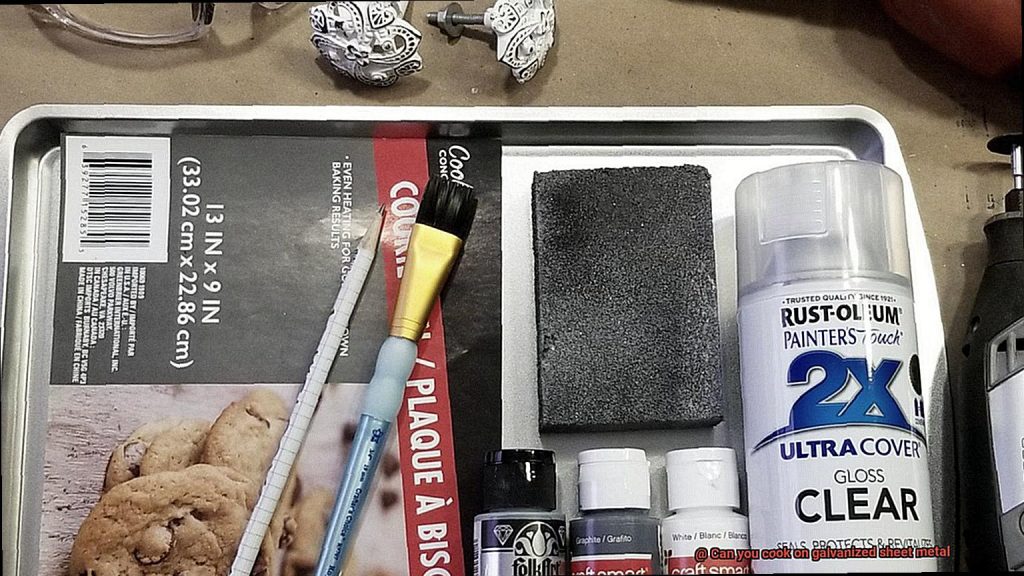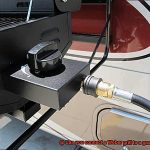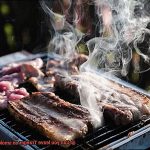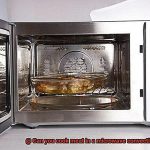Do you love the great outdoors and cooking up a storm? If so, you’re probably on the hunt for the perfect surface to cook on. But have you ever considered using galvanized sheet metal for your culinary creations?
Galvanized sheet metal is commonly used in construction and manufacturing due to its anti-corrosion properties. However, when it comes to cooking, opinions are divided. Some say it’s safe while others suggest avoiding it altogether. Confusing, right?
Well, fear not. In this article, we aim to answer the big question: Can you cook on galvanized sheet metal? We’ll explore the risks and benefits of using this material for cooking and provide actionable tips for safe cooking practices.
But that’s not all. We’ll also dive deep into the science behind galvanized sheet metal and discover why it’s such a popular material in construction. So join us on this journey as we uncover the truth about cooking on galvanized sheet metal and help you make an informed decision for your next outdoor cooking adventure.
Contents
What is Galvanized Sheet Metal?
Galvanized sheet metal is a versatile material that has been coated with zinc to protect it from rust and corrosion. The galvanization process involves dipping the steel into a molten zinc bath, which creates a chemical reaction that bonds the two metals together. This coating not only makes the steel more durable and resistant to scratches and abrasions, but also gives it a shiny silver appearance.
The applications for galvanized sheet metal are vast and varied. It is commonly used in roofing, siding, gutters, HVAC systems, and outdoor furniture. It is also found in the construction of industrial buildings, bridges, and highways. Due to its aesthetic appeal, it can be painted over or left as is for a modern, industrial look.
Despite its usefulness in construction, galvanized sheet metal should never be used for cooking. Exposure to high temperatures can cause the zinc coating to break down and release toxic fumes that can be harmful if inhaled. The Occupational Safety and Health Administration (OSHA) has even issued warnings about the dangers of welding or cutting galvanized metal due to the risk of inhaling zinc fumes.
Although some may argue that they have cooked on galvanized sheet metal without experiencing any ill effects, the risks are real and should not be ignored. Inhaling zinc fumes can result in symptoms such as fever, chills, nausea, headache, and difficulty breathing. Long-term exposure can even lead to more severe health problems like lung damage and cancer.

As a result, it’s crucial to prioritize safety when it comes to food preparation and cooking equipment. Instead of using galvanized sheet metal for cooking purposes, opt for safer alternatives like stainless steel or cast iron. These materials are more suitable for cooking and do not pose the same health risks as galvanized sheet metal.
The Dangers of Cooking on Galvanized Sheet Metal
While this type of steel may seem like a durable and versatile material, it actually poses serious health risks when exposed to high temperatures.
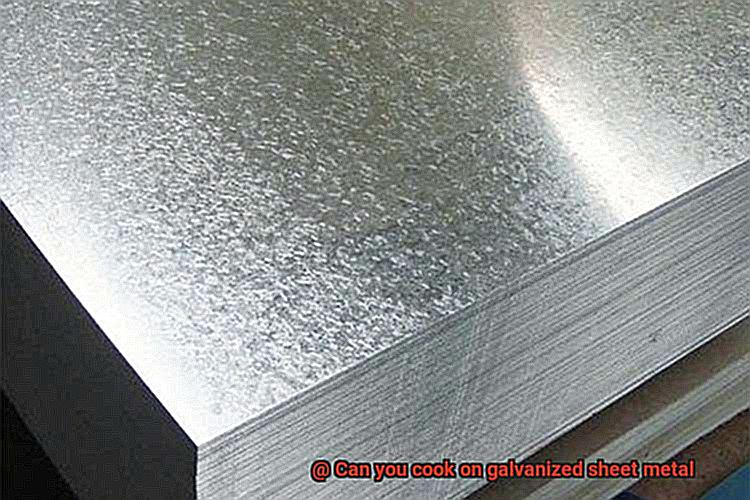
The main danger of cooking on galvanized sheet metal is the release of toxic fumes when heated. These fumes are primarily made up of zinc oxide and can cause nausea, dizziness, and headaches in the short-term. However, prolonged exposure to these fumes can lead to more severe respiratory issues and even lung damage.
But that’s not all – there is also a risk of the metal itself becoming damaged during the cooking process. When exposed to high heat, galvanized sheet metal can become distorted or warped, which could lead to potential safety hazards.
To ensure your safety and well-being, it’s best to avoid using galvanized sheet metal altogether for cooking or grilling. Instead, consider safer alternatives like stainless steel or cast iron. These materials are just as durable and effective but don’t come with the same health risks as galvanized sheet metal.
If you do find yourself needing to use galvanized metal for a project, take appropriate safety precautions. Wear a respirator and work in a well-ventilated area to minimize your exposure to toxic fumes. And remember, always prioritize safety when it comes to food preparation – your health depends on it.
Health Risks Associated with Inhaling Zinc Fumes
Galvanized sheet metal is a popular material used to prevent rusting, but it can also pose serious health risks if not handled correctly. As an expert on the health risks associated with inhaling zinc fumes, let me tell you: it’s not something to take lightly.
When heated to high temperatures, galvanized sheet metal releases zinc fumes that can cause metal fume fever. This condition can make you feel like you have the flu, causing fever, chills, headache, muscle aches, and fatigue. Not exactly a walk in the park.
But that’s not all. Inhaling zinc fumes over a prolonged period can lead to respiratory issues like bronchitis and pneumonia, as well as damage to the central nervous system that can cause dizziness, headaches, and even seizures.
If you are regularly exposed to zinc fumes, such as welders or those who work in galvanizing plants, you need to be extra cautious. But even occasional exposure can have harmful effects on your health. That’s why it’s crucial to use safe cooking equipment made from materials like stainless steel or cast iron.
To protect yourself from these harmful fumes, appropriate safety precautions must be taken. Always work in a well-ventilated area and wear a respirator if needed. By doing so, you can prevent short-term symptoms like nausea and dizziness and long-term respiratory issues and lung damage.
Your health is worth protecting. Don’t put yourself at risk for temporary discomfort or permanent damage. Instead, choose safer alternatives and take appropriate safety measures when handling galvanized sheet metal. Remember: prevention is key.
OSHA Warnings About Welding and Cutting Galvanized Metal
Galvanization is a process that involves coating steel or iron with zinc to prevent rusting. However, when this coated metal is heated to high temperatures, it can release fumes that pose significant health risks.
The Occupational Safety and Health Administration (OSHA) has issued warnings about welding or cutting galvanized metal due to the release of toxic zinc fumes. These fumes can cause symptoms such as dizziness, nausea, and even metal fume fever. To minimize exposure to these harmful fumes, OSHA recommends that workers wear protective gear such as respiratory masks and gloves while working with galvanized metal.
It’s also worth noting that cooking on galvanized metal can impact the taste and quality of food. The zinc coating can react with acidic ingredients in food, causing a metallic taste or discoloration. Therefore, culinary experts do not recommend using galvanized metal for cooking purposes.
To ensure your safety, it’s best to use alternative materials such as stainless steel or cast iron for cooking. These materials are safer and do not pose any health risks when exposed to high temperatures.
Alternatives to Galvanized Sheet Metal for Cooking Purposes
You’ll be pleased to know that there are plenty of safer alternatives out there that are both effective and easy to use.
First on our list of alternatives is stainless steel. This durable and non-reactive material is perfect for cooking outdoors and is a favorite among home cooks. Its easy-to-clean surface makes it an obvious choice for those who value convenience.
Cast iron is another great option that has been trusted by chefs for generations. Its excellent heat retention and even heat distribution make it ideal for outdoor cooking, while its natural non-stick properties make it a joy to use. Cast iron cookware can be used on a variety of heat sources, including the grill, so it’s a versatile choice as well.
Copper cookware is a slightly more expensive option, but its precise temperature control and excellent heat conductivity make it worth the investment. Copper cookware is sure to impress any home chef looking to take their cooking game to the next level.
Lastly, ceramic cookware is becoming increasingly popular as a safe and effective alternative to galvanized sheet metal. Not only is ceramic non-reactive, meaning it won’t leach harmful chemicals or metals into your food, but it’s also great for low-heat cooking. Ceramic cookware can be used in the oven or on the grill, making it a versatile choice that’s sure to impress.
Is it Safe to Cook on Galvanized Sheet Metal?
While it may seem like a durable and practical option, there are some significant risks to consider.
One of the main concerns with galvanized sheet metal is the zinc coating that covers it. When heated to high temperatures, this coating can release toxic fumes that can be harmful if inhaled. This can lead to metal fume fever, which causes flu-like symptoms such as fever, chills, and muscle aches. So, why risk your health and wellbeing for the sake of using this material?
But wait, there’s more. The zinc coating on galvanized sheet metal can also leach into the food being cooked if it becomes scratched or damaged. This can pose a risk of zinc contamination, which could lead to nausea, vomiting, and other digestive issues.
So what should you do instead? Opt for safer and more effective alternatives such as stainless steel, cast iron, copper, or ceramic cookware. These materials offer durability, non-reactive surfaces, excellent heat distribution, natural non-stick properties, precise temperature control, and versatility for any outdoor cooking needs.
But if you must use galvanized sheet metal for your cooking needs, here are some precautions you should take:
- Avoid using acidic foods that can speed up the leaching process.
- Season the metal before use by coating it with oil and heating it in the oven until it develops a non-stick surface.
- Handle the metal with care and avoid scratching or damaging the zinc coating.
Tips for Safer Cooking Practices
Cooking on galvanized sheet metal can be a risky business if safety precautions are not taken seriously. The zinc coating on the metal can release toxic fumes when heated, which can be hazardous to your health. To ensure a safe cooking experience, here are five tips for safer cooking practices on galvanized sheet metal:
Choose non-galvanized cookware
Using cast iron, stainless steel, or aluminum cookware is a safer option than using galvanized sheet metal. These materials do not release toxic fumes and are durable enough to withstand high-heat cooking methods.
Properly maintain cooking equipment
Regularly cleaning and maintaining your grill or smoker is essential to prevent the zinc coating from wearing off and exposing the underlying metal to rust and corrosion. This will help prolong the life of your equipment and keep you safe while cooking.
Cook in a well-ventilated area
Cooking in a well-ventilated area is crucial when using galvanized sheet metal as it helps to reduce the concentration of toxic fumes that may be released during cooking. Open windows or use a fan to ensure proper ventilation.
Handle galvanized sheet metal with care
Always wear gloves and protective clothing when handling any galvanized metal products to avoid direct skin contact. Zinc can cause skin irritation, so it’s best to take precautions.
Clean thoroughly before use
It’s important to remove any dirt or debris from the surface of the galvanized sheet metal before cooking to prevent contamination. Use soap and water or a degreaser to clean the surface thoroughly.
h9PWFGqy7PI” >
Conclusion
In conclusion, it’s essential to prioritize safety when it comes to cooking. While galvanized sheet metal may be a versatile material for construction and manufacturing, it should never be used for food preparation. The zinc coating on the metal can break down at high temperatures, releasing toxic fumes that are harmful if inhaled. Ignoring these risks can result in symptoms like fever, chills, nausea, and even long-term health problems like lung damage and cancer.
To avoid these dangers, opt for safer materials like stainless steel or cast iron when cooking. These materials are better suited for food preparation and do not pose the same health risks as galvanized sheet metal. However, if you must use galvanized metal, take appropriate safety precautions like wearing a respirator and working in a well-ventilated area.
Remember that prevention is key when it comes to protecting yourself from the harmful effects of inhaling zinc fumes or other toxins associated with unsafe cooking practices.

